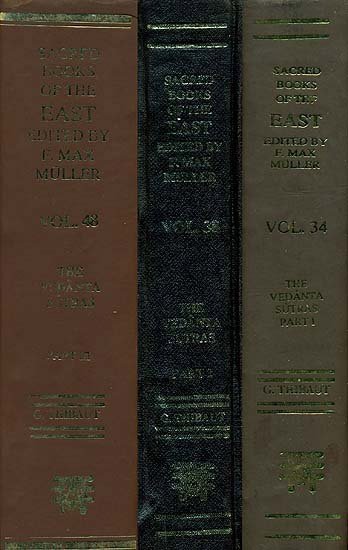Brahma Sutras (Ramanuja)
by George Thibaut | 1904 | 275,953 words | ISBN-10: 8120801350 | ISBN-13: 9788120801356
The English translation of the Brahma Sutras (also, Vedanta Sutras) with commentary by Ramanuja (known as the Sri Bhasya). The Brahmasutra expounds the essential philosophy of the Upanishads which, primarily revolving around the knowledge of Brahman and Atman, represents the foundation of Vedanta. Ramanjua’s interpretation of these sutras from a V...
Sutra 2.2.36
36. (The system) of the Lord (must be disregarded), on account of inappropriateness.
So far it has been shown that the doctrines of Kapila, Kaṇāda, Sugata, and the Arhat must be disregarded by men desirous of final beatitude; for those doctrines are all alike untenable and foreign to the Veda. The Sūtras now declare that, for the same reasons, the doctrine of Paśupati also has to be disregarded. The adherents of this view belong to four different classes—Kāpālas, Kālāmukhas, Pāśupatas, and Śaivas. All of them hold fanciful theories of Reality which are in conflict with the Veda, and invent various means for attaining happiness in this life and the next. They maintain the general material cause and the operative cause to be distinct, and the latter cause to be constituted by Paśupati. They further hold the wearing of the six so-called 'mudrā' badges and the like to be means to accomplish the highest end of man.
Thus the Kāpālas say, 'He who knows the true nature of the six mudrās, who understands the highest mudrā, meditating on himself as in the position called bhagāsana, reaches Nirvāṇa. The necklace, the golden ornament, the earring, the head-jewel, ashes, and the sacred thread are called the six mudrās. He whose body is marked with these is not born here again.'—Similarly the Kālāmukhas teach that the means for obtaining all desired results in this world as well as the next are constituted by certain practices—such as using a skull as a drinking vessel, smearing oneself with the ashes of a dead body, eating the flesh of such a body, carrying a heavy stick, setting up a liquor-jar and using it as a platform for making offerings to the gods, and the like. 'A bracelet made of Rudrāksha-seeds on the arm, matted hair on the head, a skull, smearing oneself with ashes, etc.'—all this is well known from the sacred writings of the Saivas. They also hold that by some special ceremonial performance men of different castes may become Brāhmaṇas and reach the highest āśrama: 'by merely entering on the initiatory ceremony (dīkshā) a man becomes a Brāhmaṇa at once; by undertaking the kāpāla rite a man becomes at once an ascetic.'
With regard to these views the Sūtra says 'of pati, on account of inappropriateness.' A 'not' has here to be supplied from Sūtra 32. The system of Paśupati has to be disregarded because it is inappropriate, i.e. because the different views and practices referred to are opposed to one another and in conflict with the Veda. The different practices enumerated above, the wearing of the six mudrās and so on, are opposed to each other; and moreover the theoretical assumptions of those people, their forms of devotion and their practices, are in conflict with the Veda. For the Veda declares that Nārāyaṇa who is the highest Brahman is alone the operative and the substantial cause of the world, 'Nārāyaṇa is the highest Brahman, Nārāyaṇa is the highest Reality, Nārāyaṇa is the highest light, Nārāyaṇa is the highest Self'; 'That thought, may I be many, may I grow forth' (Ch. Up. VI, 2, 3); 'He desired, may I be many, may I grow forth' (Taitt. Up. II, 6, 1), and so on. In the same way the texts declare meditation on the Supreme Person, who is the highest Brahman, to be the only meditation which effects final release; cp. 'I know that great Person of sunlike lustre beyond the darkness. A man who knows him passes over death; there is no other path to go' (Śvet. Up. III, 8). And in the same way all texts agree in declaring that the works subserving the knowledge of Brahman are only those sacrificial and other works which the Veda enjoins on men in the different castes and stages of life: 'Him Brāhmaṇas seek to know by the study of the Veda, by sacrifice, by gifts, by penance, by fasting. Wishing for that world only, mendicants wander forth from their homes' (Bṛ. Up. XI, 4, 22). In some texts enjoining devout meditation, and so on, we indeed meet with terms such as Prajāpati, Śiva, Indra, Ākāśa, Prāṇa, etc., but that these all refer to the supreme Reality established by the texts concerning Nārāyaṇa—the aim of which texts it is to set forth the highest Reality in its purity—, we have already proved under I, 1, 30. In the same way we have proved under Sū. I, 1, 2 that in texts treating of the creation of the world, such as 'Being only this was in the beginning,' and the like, the words Being, Brahman, and so on, denote nobody else but Nārāyaṇa, who is set forth as the universal creator in the account of creation given in the text, 'Alone indeed there was Nārāyaṇa, not Brahmā, not Iśāna—he being alone did not rejoice' (Mahopanishad I).—As the Paśupati theory thus teaches principles, meditations and acts conflicting with the Veda, it must be disregarded.
